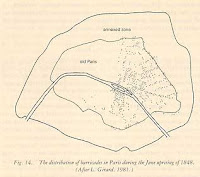The Hotel de Sens Caught in the Crossfire, 1830
 Wednesday, June 9, 2010 at 7:11AM Tweet
Wednesday, June 9, 2010 at 7:11AM Tweet 
On 28 July 1830, the Hôtel de Sens, one of Paris' only remaining residences dating from the Middle Ages, was caught in the crossfire between barricaded revolutionaries and the troops of King Charles X.
 Check out the cannon shot still embedded in the facade above the 1st floor mullioned window: a très cool souvenir from Les Trois Glorieuses of 27-29 July 1830.
Check out the cannon shot still embedded in the facade above the 1st floor mullioned window: a très cool souvenir from Les Trois Glorieuses of 27-29 July 1830.
Built more than 300 years before the Glorious Revolution (1474 to 1519), the Hôtel de Sens was once the home of the Archbishops of Sens. The architecture of the Hôtel boasts both late Gothic and early Renaissance features as well as many medieval defensive elements:
- surveillance turrets;
- a square tower used as the dungeon;
- an arched entryway with chutes from which defenders could pour scalding water or oil on would-be invaders.

In 1605, King Henri IV's ex-wife, Queen Margot, moved into the Hôtel de Sens. She was notorious for her many love affairs and is rumored to have collected the hair of her lovers to make her wigs.
From 1689-1743 the Hôtel de Sens became a stagecoach office. Sometime thereafter, it reverted once again to the Archbishops of Paris.
That is, until the July Revolution of 1830.
 Post a Comment | |
Post a Comment | |  Email Article |
Email Article |  Print Article | tagged
Print Article | tagged  Barricades,
Barricades,  Charles X,
Charles X,  Hotel de Sens,
Hotel de Sens,  July Revolution,
July Revolution,  Les Trois Glorieuses |
Les Trois Glorieuses |  Permalink
Permalink 





